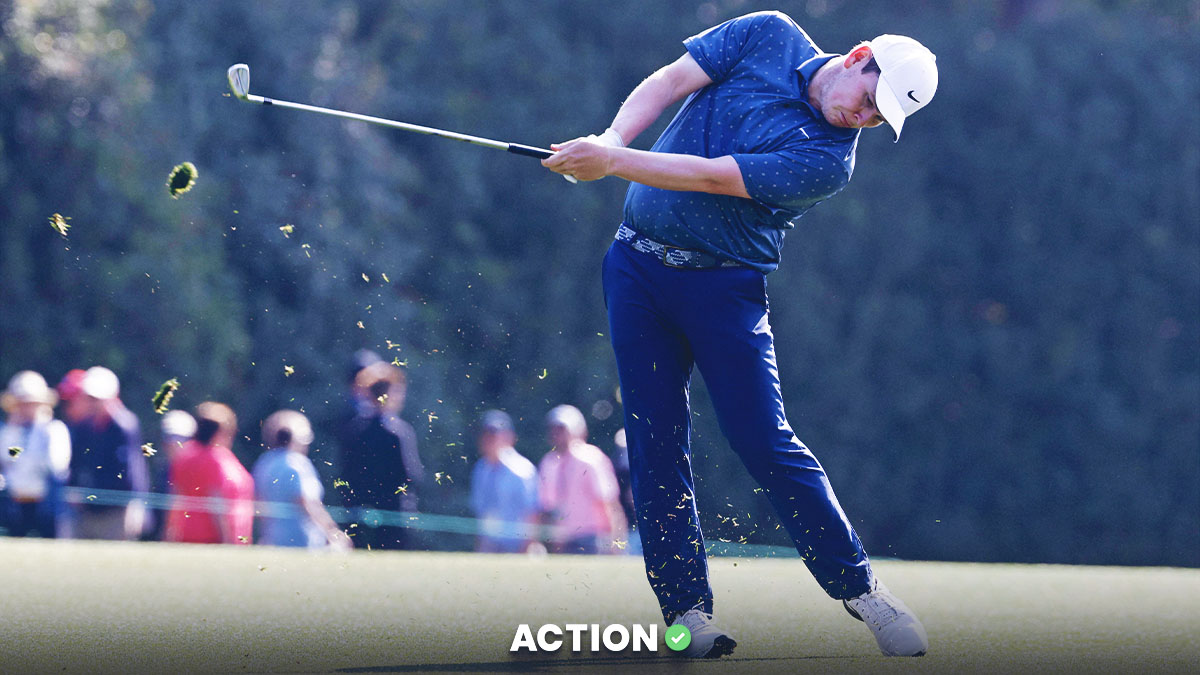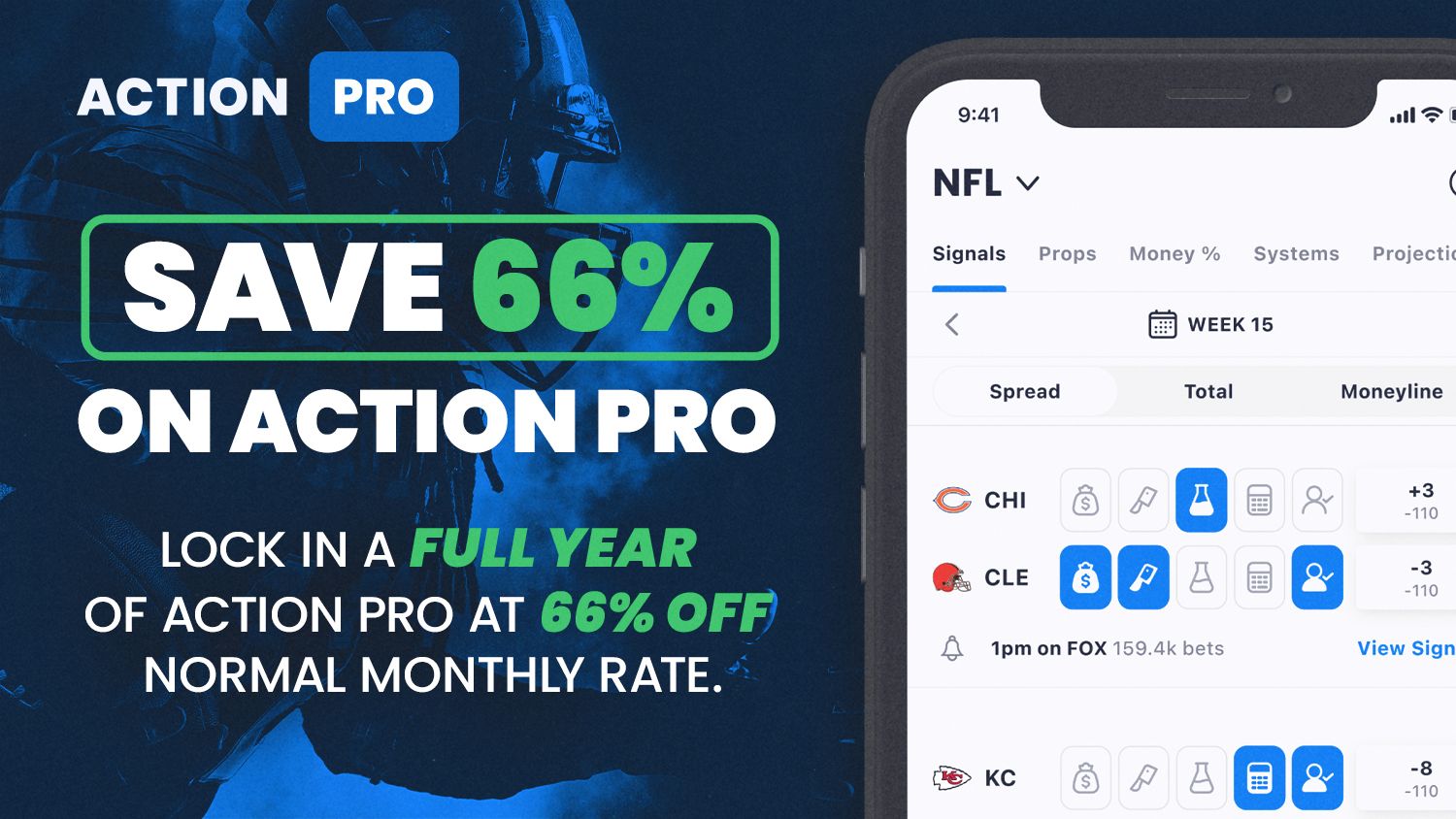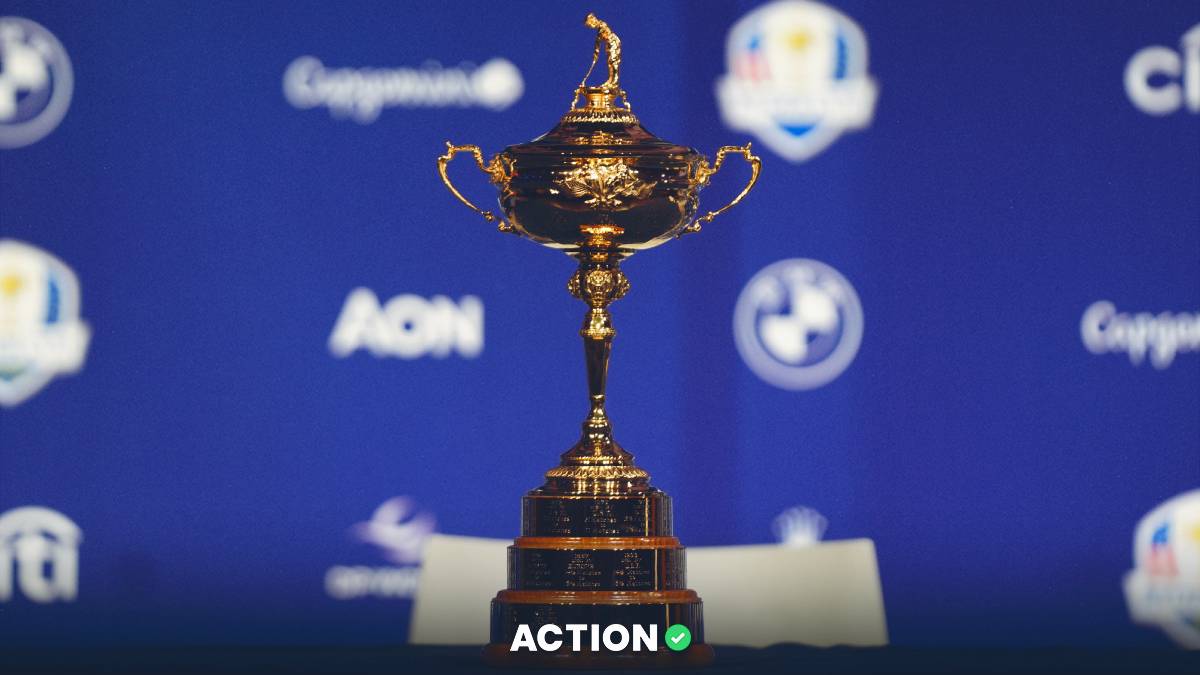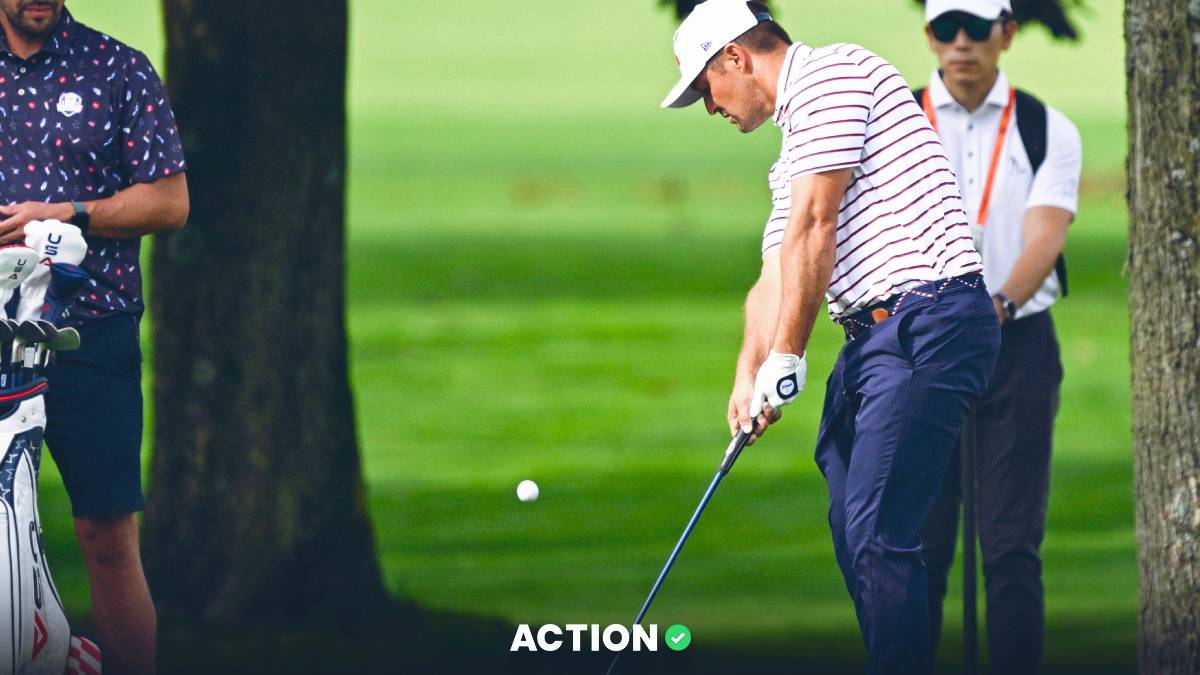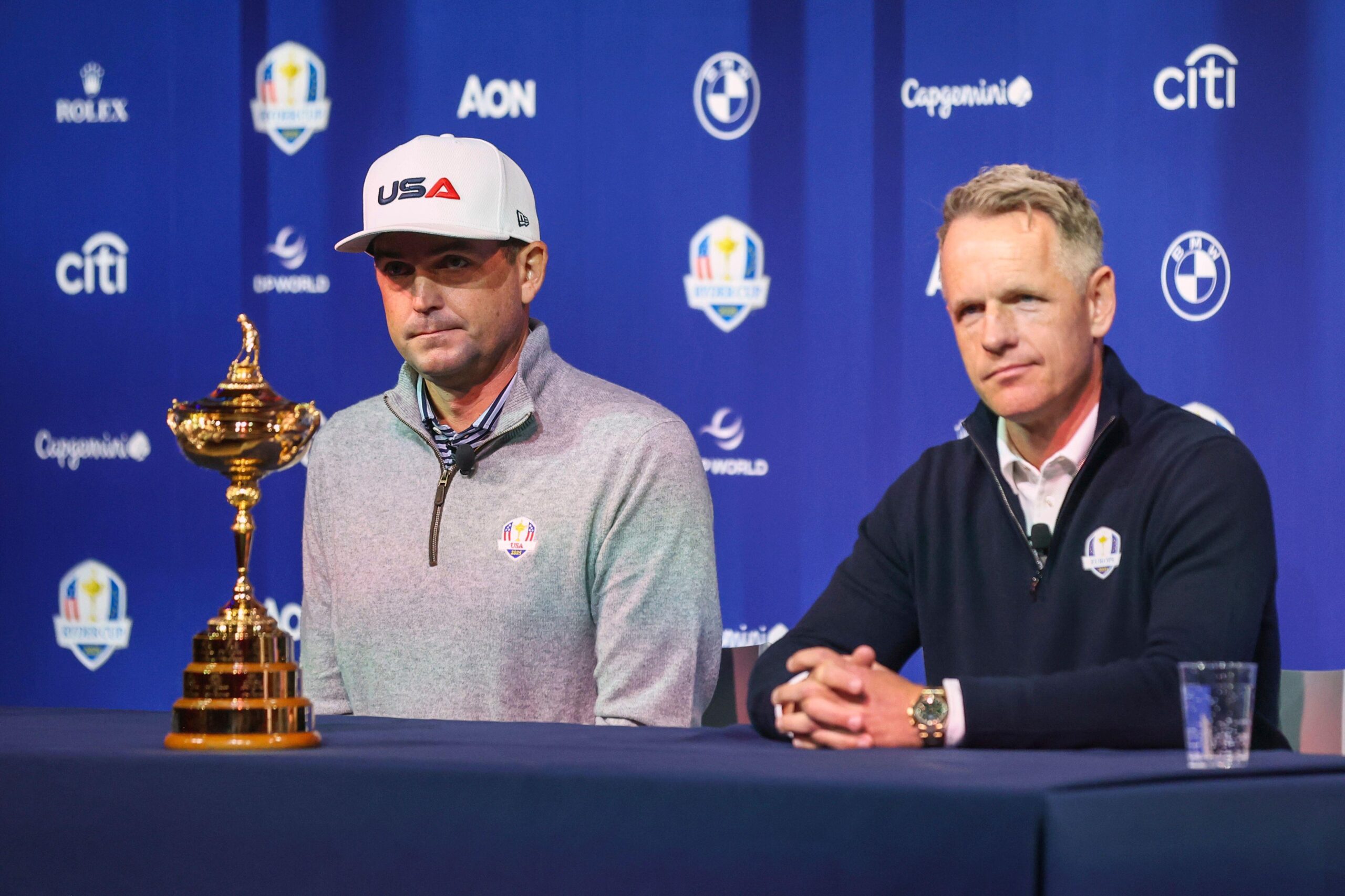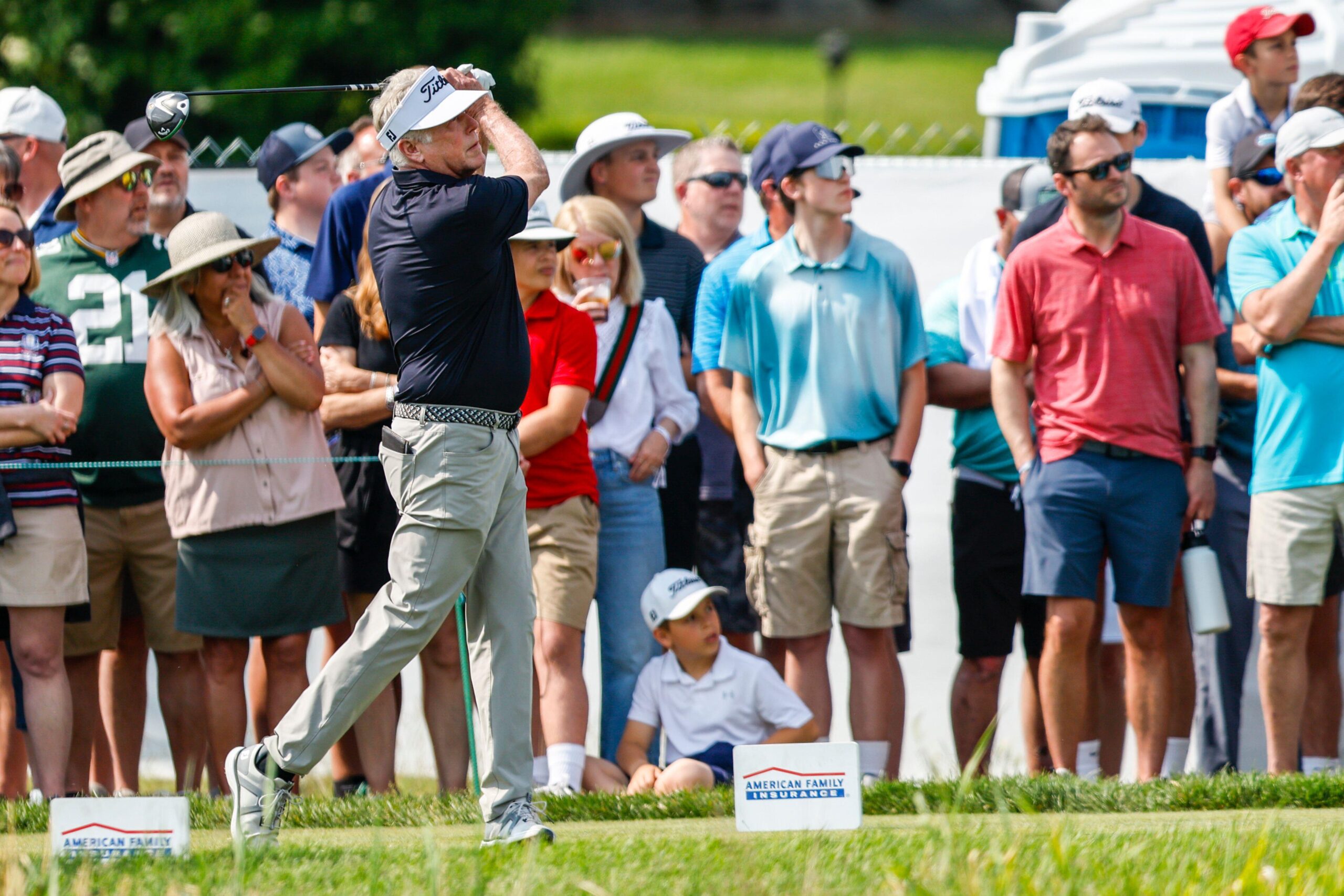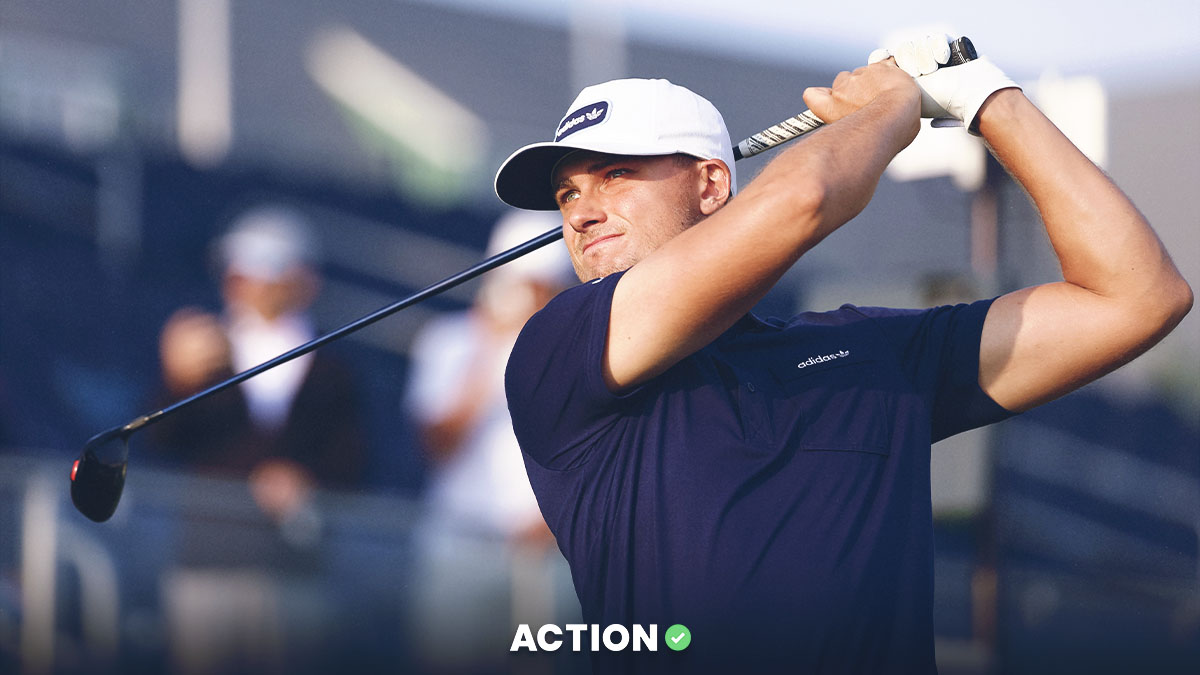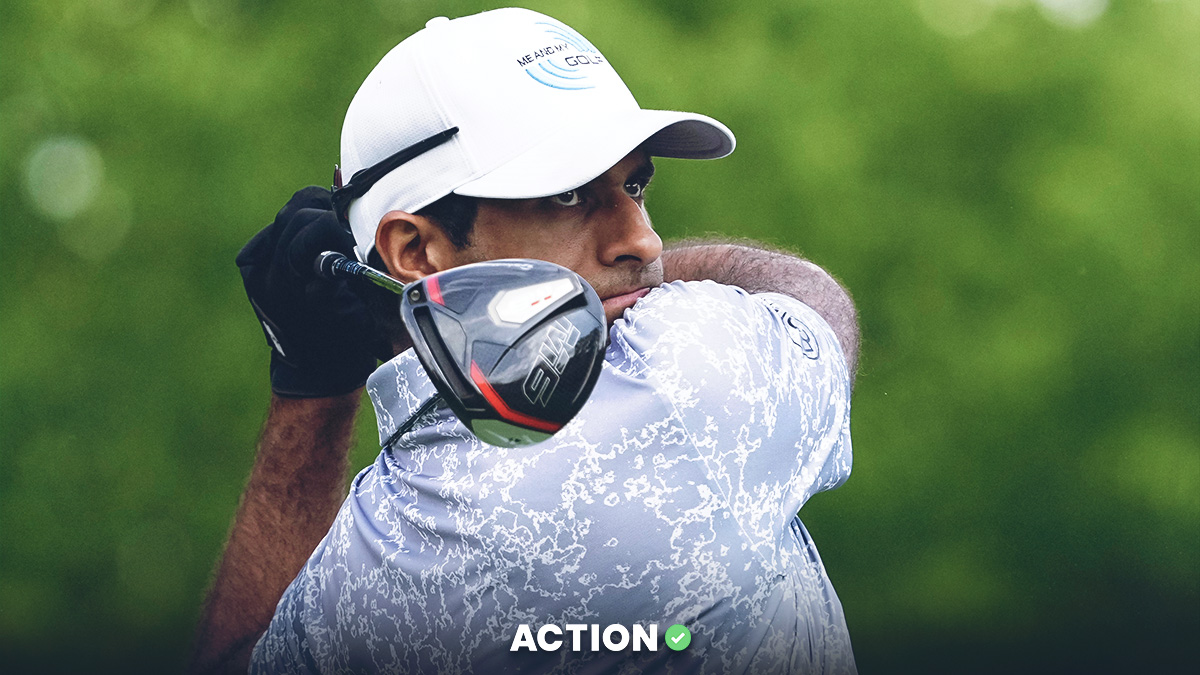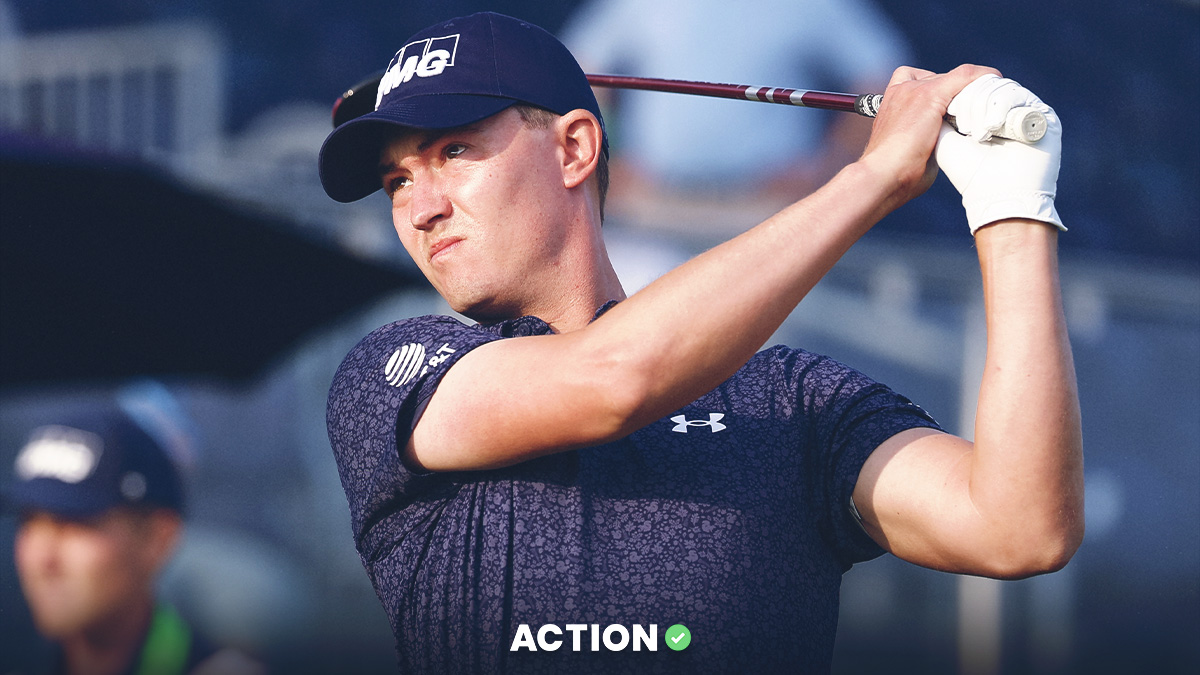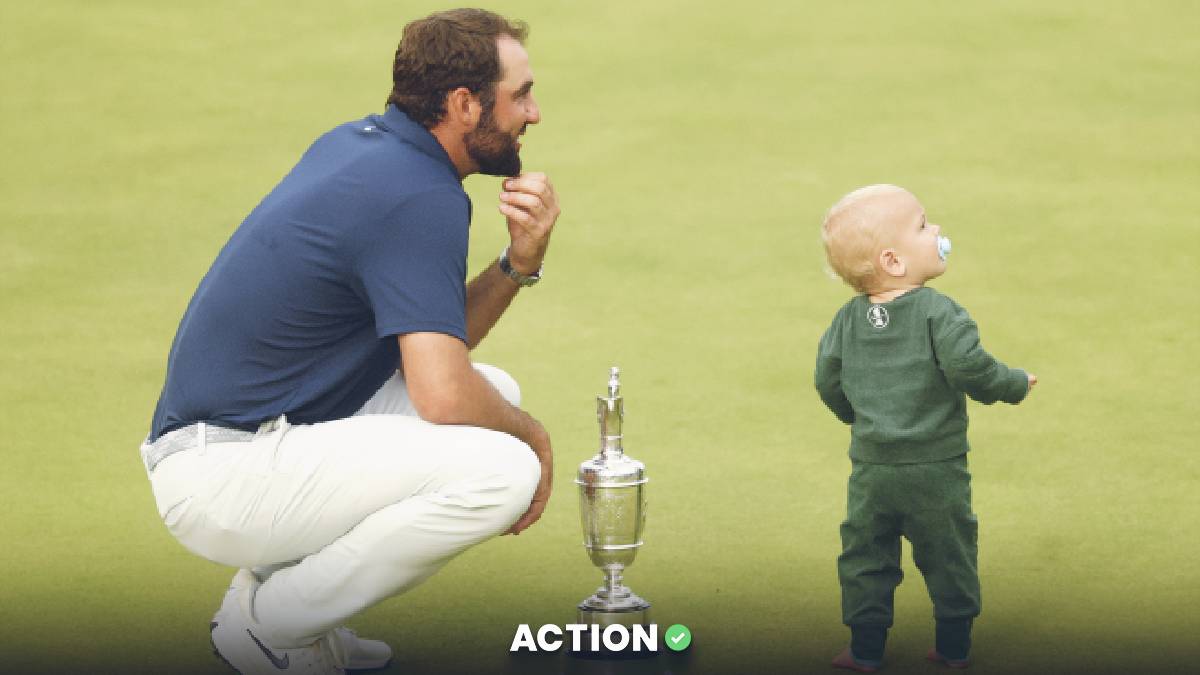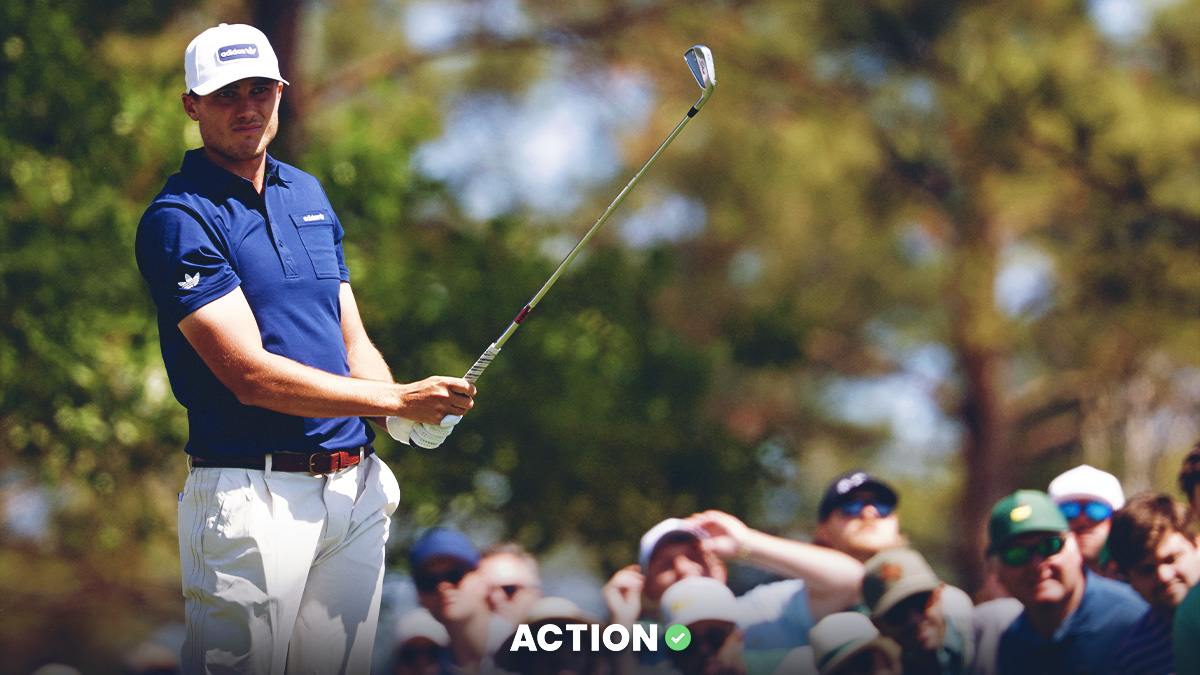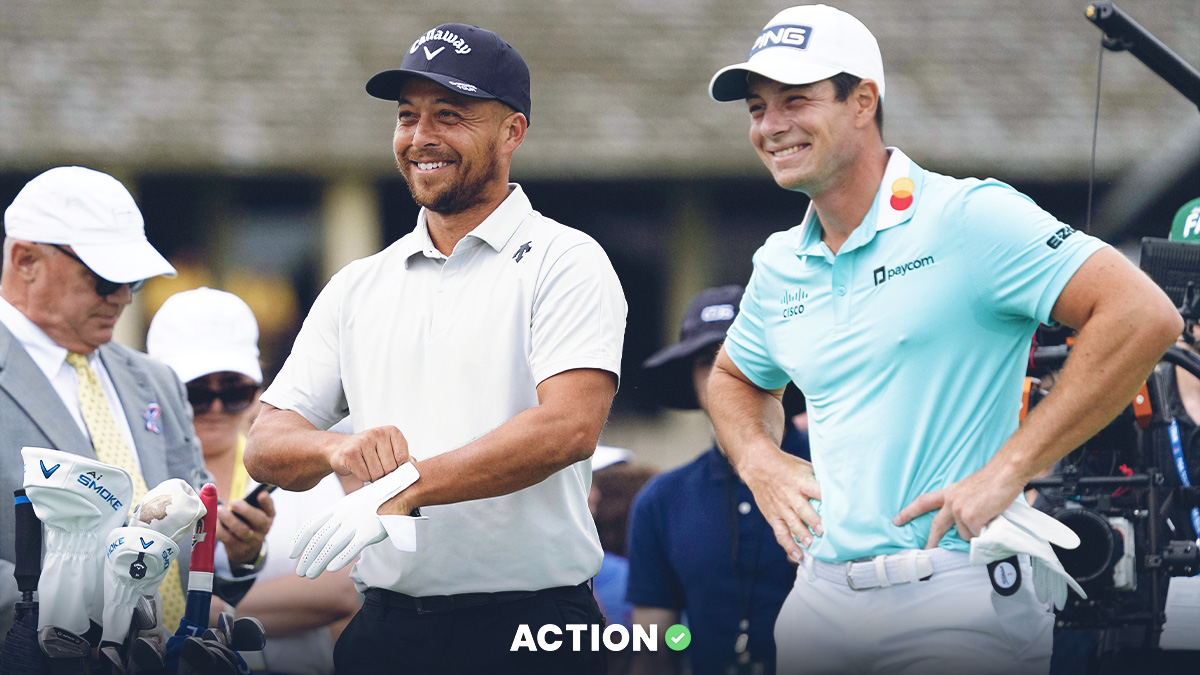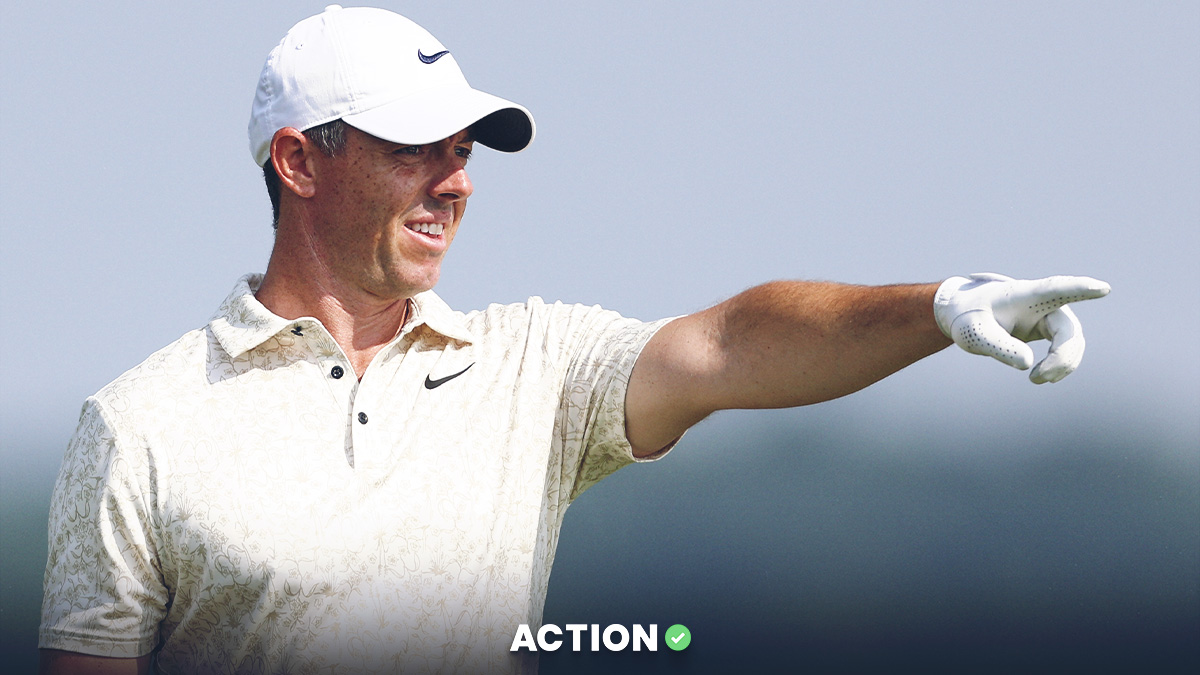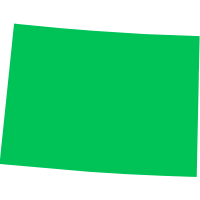Do you want to win your PGA Championship pool? Like actually win? Or just finish 20th and win no money?
Our typical recommendation for mass-entry pools like this — in which everyone can use the same teams/players — involves skipping the most popular sections in many tiers and trying to find comparable players who will be far less selected. That creates leverage over the field, elevating you in the standings when your players do well, because those players are part of far fewer other teams. We write about this strategy NHL playoff pools, NCAA Tournament brackets, NFL survivor pools and more. Sean Koerner's contrarian March Madness bracket just cashed Florida in the national title game. Our 2025 Masters pool piece had some hits and misses, but ultimately would have fallen well short of the money in any pool because so many people used winner Rory McIlroy, and I didn't.
Following this strategy, you'll lose a lot of the time. But to quote an old but timeless piece of advice from Matthew Freedman, once of FantasyLabs: The contrarian is less focused on the outcome of one act and more focused on the positive results that a thorough and consistent program of contrarianism eventually yields.
There are many ways to set up a golf pool, but a typical pool involves "Tiers" in which you pick one golfer from each tier, and their total scores will be added up to create your team's overall score. This prevents everyone from taking the six best golfers and calling it a day.
We'll use EasyOfficePools' standard tiers that use betting odds to sort the tiers, picking one player from the top five tiers and three players from the "everyone else" tier. Let's assume there are 100 people in the pool, and the top four finishers get paid.
Tier 1 will look something like this:
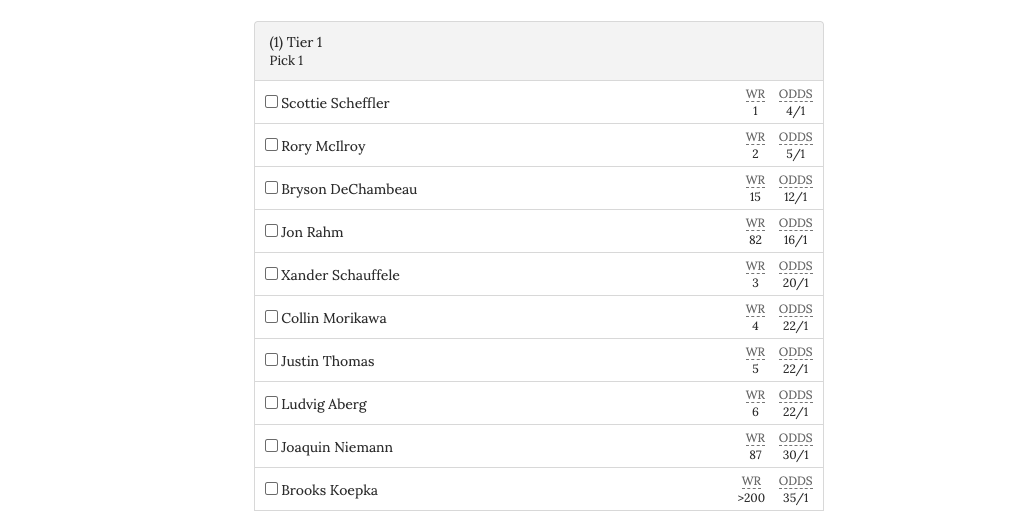
Alright, to the tips and strategy. Much of this will be the same as I wrote for the Masters, because the broader strategy doesn't really change tournament-to-tournament.
1. Don't Try to 'Do Well.' Try to Win.
To win these pools, you need to win. Finishing 20th of 100 pays the same at 99th — you get nothing.
So, you need to differentiate your lineup if you want to win. And you need to get comfortable with the idea that some years, you may come in dead-last by fading the "can't miss" players everyone wants to use. But I'd rather win one in 10 times and come in last the other nine than finish 40th for 10 straight tournaments.
That doesn't mean you should take all the worst players — take comparable players who will be less used. That will give you leverage over your pool.
If you do take Rory McIlroy, whose played the best golf of anyone this year and has won four times at Quail Hollow, make sure the rest of your picks are unpopular so you can create a unique lineup. If you fade McIlroy, you can use some popular players in other tiers.
2. Just Pick Good Golfers
A few years ago at FantasyLabs, we analyzed millions of DFS lineups and found that floor is much more important than ceiling in golf DFS, because the only thing that correlates with DFS success is making the cut. If you stay in the tournament, you raise your ceiling. This is also true for pools; if any of your players miss the cut, you're toast.
The takeaway from that article that stuck with me most: "Just try to make as many 6/6 lineups as you can and hope that at least one of them has everyone score high."
The abundance of modern sports statistics lead you down the wrong path sometimes. Golf is an inherently random game in a given day, so don't take putting, the most random part, and narrow the sample to just a certain type of grass. Just take the good players who hit the ball far and put it close to the hole. In the long run, those players will win out.
You don't have to pick players in Tiers 5 and 6 who you think will win the tournament; they're in those tiers because they won't win. So, take good players who you think will play well; don't worry so much about "winning upside."
DataGolf's rankings are the industry standard for true rankings of a golfer's underlying ability. Here are some guys ranked higher that you wouldn't expect, or who you've never heard of:
17. Daniel Berger: Berger is basically all the way back following two injury-riddled seasons. He's been 25th or better in nine of 12 tournaments this calendar year.
19. Keegan Bradley: When you think Ryder Cup captains, you think older players sunsetting off onto the senior tour, but Bradley is still playing at a high level. His ball-striking is still among the best in the world, but his putter has been ice-cold for the last few months. I'd bet on the putter returning to at least break-even for him this week.
35. MacKenzie Hughes: After dropping out of the DataGolf top 100 in March, he's all the way up to 35th on the back of improved play off the tee and on approach. Hughes has always been elite on and around the greens, but getting more out of his driver will be the key to unlocking a big finish this week.
45. Rasmus Neergaard-Petersen: The Dane, one of several young players from Denmark who have a bright future on tour, has risen from outside the DG Top 500 to inside the top 50 over the last 14 months. He's only played twice on the PGA Tour, a solo 2nd and T22, and has been on a remarkable run of top finishes on the DP World Tour without a win.
71. Kevin Yu: Yu jumped 24 spots in the DG rankings after a fourth-place finish at the Myrtle Beach Classic last week. Another great ballstriker who doesn't putt well, Yu was a popular sleeper for the Masters, and anyone who used him may be scared off this week.
83. Rico Hoey: Never heard of him? Great. Hoey is a great ballstriker who thrived in the PGA Tour's fall swing and has posted three finished of T12 or better in his last seven events.
3. Getting Leverage on the Field
Here's where we start to get weird.
Leverage is the idea that you can create value by choosing lower-owned players who have a comparable chance to play well as a similar, higher-owned player. If 50% of the pool uses McIlroy and he does well, 50% of your pool will move up in the standings when he does well. But if you're the only person who uses Si Woo Kim and he finishes fourth, you're moving up the standings alone if he plays well.
With 100 people in your pool, would you rather be:
- One of 30 people with Corey Conners (2.1% chance to win)
- One of five people who uses Robert MacIntyre (1.9% chance to win)
To me, the answer is clear. The chances of them winning aren't that different, but what you're gaining on the field if MacIntyre does well is massive.
Here are the top players in our FantasyLabs DFS models in leverage score, which compares projected ownership to upside. It's DFS, so it's a bit different, but I think it gives you a decent idea of the guys that no one wants to use, and players who will be popular this week.
It's mostly players who are:
- Everyone is sick of using in these pools: Jon Rahm, Joaquin Niemann
- Guys who never win: Tommy Fleetwood
- Injury concerns: Xander Schauffele, Jason Day
- Pretty good players most people haven't heard of: Rico Hoey, Rasmus Neergaard-Petersen, Matthew McCarty
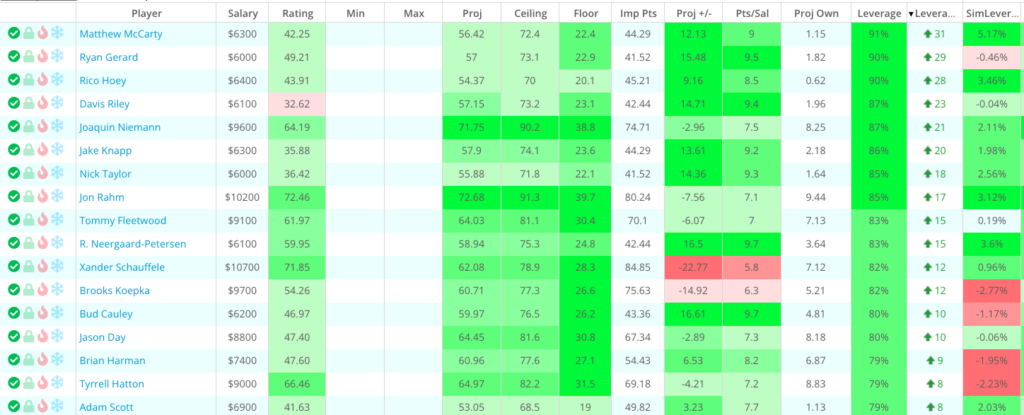
And here are the players with the highest ownership projections. It's mostly guys in great form.
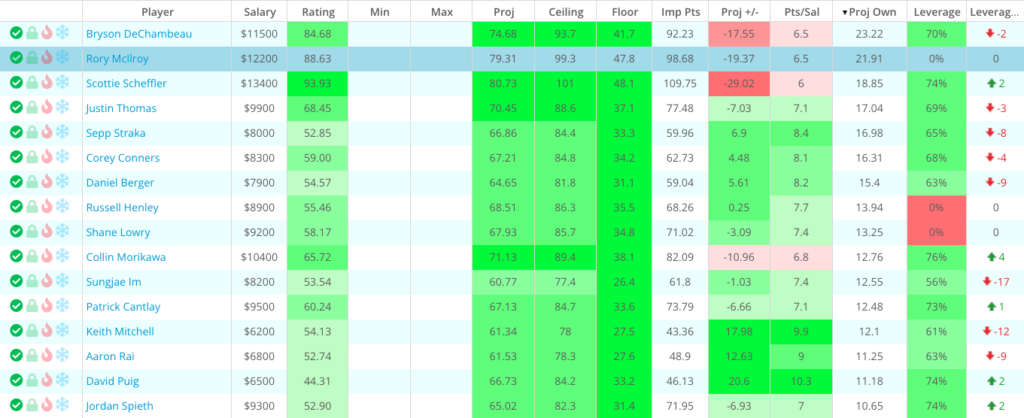
3b. Why Leverage is So Important
If 60% of a pool uses McIlroy, 60% of the entries will gain a stroke when he birdies a hole. So you're gaining a point on 40% of the field, but so is almost everyone else.
But if a 1% Hoey birdies a hole, you're moving up alone, and passing everyone else.
And the goal isn't to have the best raw score — the goal is to have a better score than your opponents.
This visual represents leaderboard movement when Rahm, owned by just two of the top 10 entries, birdies a hole, versus when Scheffler does.
If you've ever been in contention in a tiers golf pool like this, you know the changes in standings slow to a crawl on Sunday when some of your players complete their rounds and your top guys are also used by the entries you're battling for first. You may be sitting in fifth, with three players still playing, but there's no way to actually catch the guy in first because he has the same three guys.
The hard part is you don't know who will be the most-owned golfers in these pools. It's not like the NCAA Tournament, where Yahoo! and ESPN will actually tell you.
So we have to make some assumptions. We do DFS ownership projections at FantasyLabs, which can give you some idea. Tyler Tamboline on X does a good thread highlighting the most recommended players in the industry you'll probably want to avoid.
4. Use Odds as a Guide, But Also as a Pivot Point
Many people will gravitate toward the players in each tier who have the best odds to win.
Most people don't follow golf closely enough to separate top 15 players like Daniel Berger vs. Sungjae Im, let alone Ryan Gerard and Max Greyserman, so they let the betting market do it for them. That isn't a terrible approach.
But if 8% of people will use Tyrell Hatton (55-1) and 26% will use Hideki Matsuyama (45-1), you should always use Hatton.
Here's how Tier 1 looked in a pool I did in 2023. The ownership shares generally follow the odds, with a few deviations, like Patrick Cantlay going under-owned because no one likes him.
Rahm ended up being the best play in this tier since he won in 2023, and the ownership leverage you got over everyone taking Scheffler was massive. Their odds to win were pretty close (11.76% for Scheffler vs. 9.5% for Rahm), but their ownership was miles apart. Rahm made tons of sense here.
You should also not use the betting odds that your pool site gives you. They're often stale and don't update throughout the week as the betting market changes.
6. Be a Hater (or Boring)
A few years ago at the Masters, I recommended using LIV golfers because 1) many golf fans turned on them, and 2) they had all been in pretty poor form entering the Masters or hadn't played much. They had three of the top 6 finishers that year.
I also always recommend using golfers that people dislike, because you may get some small ownership advantages from that dislike alone, despite their ability being the same as a comparable player — Patrick Cantlay is the poster-child for this, but Tom Kim, Brian Harman (both slow play), Patrick Reed and Sergio Garcia may also fall into this camp.
Bryosn should be wildly popular this week, while I think most people have cooled on Jon Rahm and Joaquin Niemann. LIV has some elite drivers of the ball (outside of just Bryson DeChambeau) who may garner interest from that narrative — DeChambeau, Rahm, Niemann, Dean Burmester, David Puig, Tom McKibbin, Sergio Garcia and Eugenio Chacarra are all top 30 in the world in strokes gained off the tee.
7. Know Your Scoring & Pool Size
I may tweak my strategy based on how the scoring works, and I'll definitely tweak my entries based on how big the pool is. If there are 20 people, you don't have to get quite as creative to win. But if there are 400, you're going to need to get incredibly lucky if you use the most popular players. If you fade those guys and they flop, you're eliminating a huge chunk of the pool.
These are usually the three types of scoring setups:
Score to par: In a pool where all your players' scores are added up, I'm looking for players who offer some floor. You're probably still going to need the winner to win a big pool that scores like this, but you can't have missed cuts and you need the bottom half of your lineup to finish strong and post some Top 30s.
Total prize money: You really need upside in this scoring format, because the winner is paid something like 15x more than 20th place. I'm more willing to gamble on players with win equity but with a slightly lower floor (Viktor Hovland and Patrick Reed become more interesting in this format, where Tommy Fleetwood, Corey Conners and Denny McCarthy are a little less interesting).
Finishing position/picking the winner: Other pools score by finishing position, which is similar to score to par, but with less variance.
Knowing pool size: There's not an exact science to this, but the bigger the pool, the more contrarian you need to get. Even if you took Florida in a 20-person NCAA Tournament pool, you probably didn't win.
Again, this doesn't mean you should take the worst player in ever tier. But you need to be extra considerate of how popular your players are if you're in a big pool. Make a few key pivots to players you think almost no one will use.
8. Tier-by-Tier Breakdown
Alright, let's dive into the actual tiers on EasyOfficePools. Your pool may be slightly different, so use the general concepts — avoid what you believe will be the most popular plays in favor of comparable players who are being ignored. Don't just choose the worst player in each tier.
I'll be somewhat fading the "driving distance is essential" narrative this week, not because driving distance isn't important (it always is). But because all the players getting recommended in articles, podcasts and on TV will be the long hitters, leading to over-ownership in pools.
Tier 1
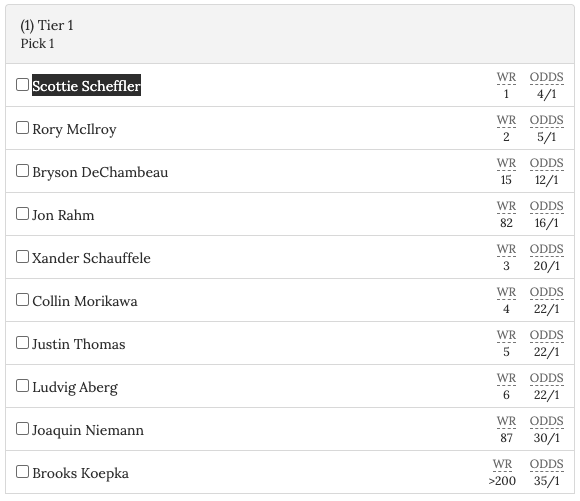
Maybe I'm wrong, but I think for the first time in forever, Scottie Scheffler won't be the highest-owned player, and now is a good time to use him. It's a little weird that he's never played this course, but that's another reason some people might stay off him.
McIlroy's got the red-hot form and course history at Quail Hollow, and the golf media is starting to treat McIlroy and Scheffler as equals again. DeChambeau's driving the ball better than anyone, maybe ever. While I don't think Scheffler will be sub-15% owned or anything like that, the other two are attracting enough attention to allow me to use him for the first time in like 2.5 years. I'll try to be different throughout the rest of my lineup for make up for it.
Other considerations: If you've read these pieces before, you know I'm a sucker for an under-used Jon Rahm. There's so much to like about the top three that I think the rest of this tier will basically go unused, so I'm fine with Thomas, Rahm, Xander, Aberg & Morikawa.
Tier 2
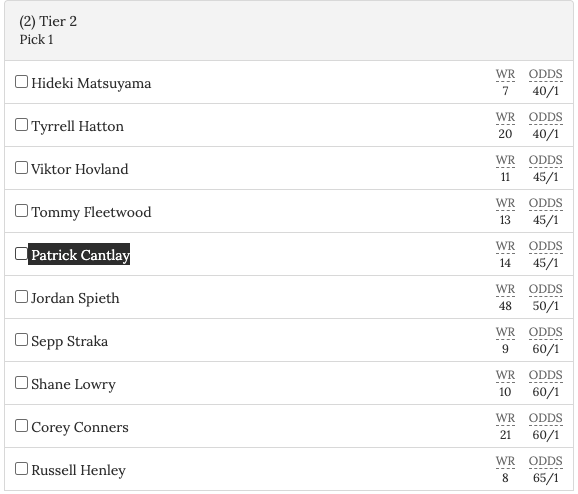
Patrick Cantlay often features in this piece, because no one ever wants to use him. I'll put any personal feelings of slow play aside to get an edge.
Cantlay has been striking the ball beautifully, a top 5 player on approach per DataGolf's skill ratings, and there aren't really any holes in his game.
Other considerations: There are a lot of names people will like in this tier, so the ownership should be pretty spread out. I'd be fine using anyone in this tier pretty much, with a lean toward Spieth, who quietly has added a lot of distance, and Corey Conners, who often comes in as the best player in lower tiers in these pools, but will probably be less-owned in this tier given the players around him.
Tier 3
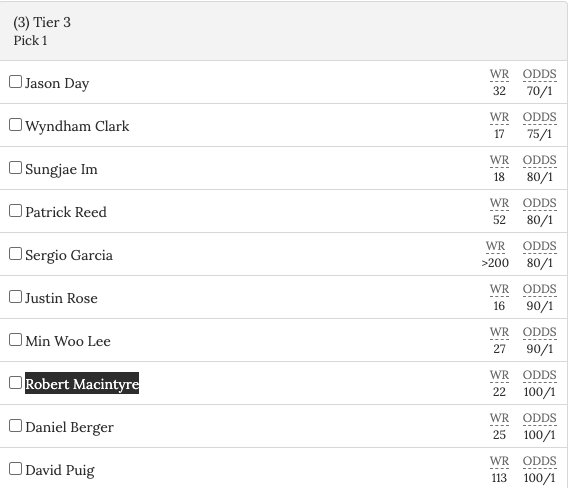
Unlike the last tier, there's a flaw in just about everyone's game in this tier. Jason Day is hurt. Wyndham Clark has won here and won a major but is in terrible form. Most people hate Patrick Reed and Sergio Garcia, to a lesser extent. Daniel Berger and Justin Rose aren't long hitters. Min Woo Lee has crazy distance but has been in bad form since winning in Houston last month. Robert MacIntyre was a trendy play coming into the Masters but missed the cut, and hasn't been great since.
This is all to say I have no idea who's going to be popular. So I'll go with Robert MacIntyre, who might be ignored because he was so trendy at Augusta. He's spiked in good fields before and was T8 at last year's PGA Championship.
Other considerations: I always like using Patrick Reed in these mass-entry settings, because no one likes him. David Puig should also go pretty unused, as the long hitter on LIV isn't known by most golf fans.
Tier 4
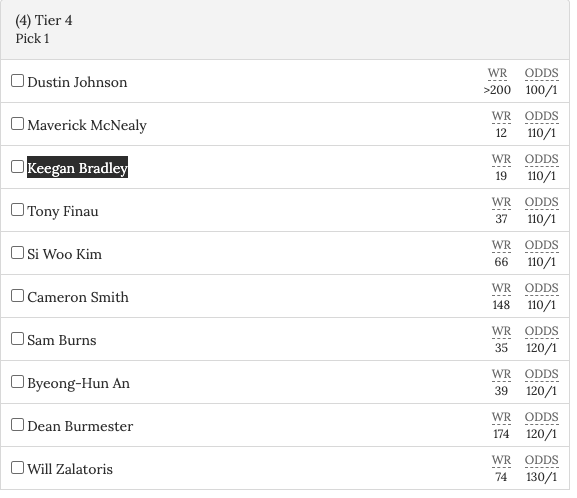
Although Keegan Bradley is strong off the tee and with his irons, I'm not really hearing him referred to as a "long hitter" fit for this setup. So perhaps he'll go under-used, and I think he has as good a chance to contend as anyone in this tier.
Dean Burmester and Byeong Hun-An might be popular sleepers, given their distance.
Other considerations: Si Woo Kim is not super long off the tee and I don't think will be used at all.
Tier 5
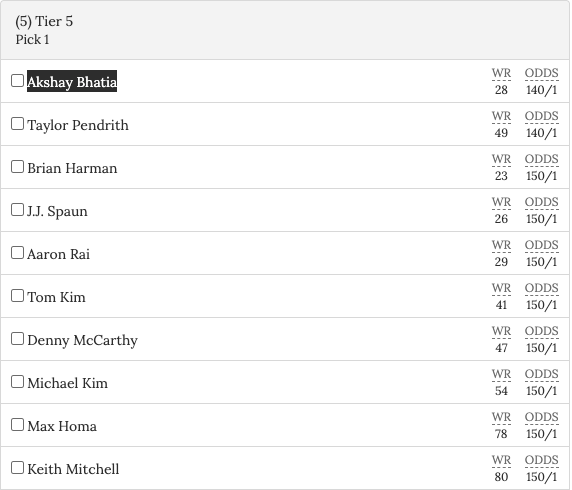
Akshay Bhatia isn't super long off the tee but he's an elite long iron player and I'll bet on guys like that any day.
I'd expect Keith Mitchell to be popular given his recent form and course history, and Max Homa to garner some ownership given his popularity and recently-improved form.
Other considerations: Aaron Rai doesn't have much distance but he still rates out well in most holistic driving metrics because of his accuracy. He's 99th percentile in driving accuracy because he rarely misses the fairway, and he's one of the best overall players in this tier.
Tier 6
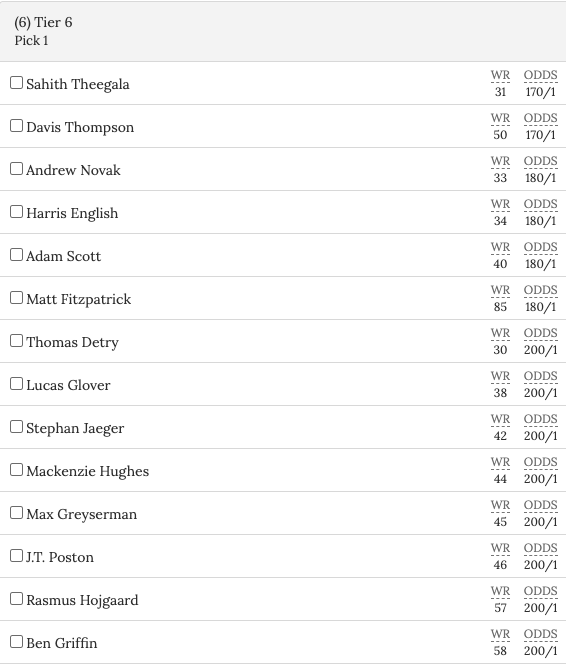
I couldn't fit every player in this screenshot, but in most pools, you'll pick multiple players from this tier.
Some players I like:
- Kevin Yu: A great ballstriker who can't putt who burned some people at the Masters when he was a popular sleeper. If you liked him then, there's no reason to not like him this week.
- Rasmus Neergaard-Petersen: RNP has been on a ridiculous run in Europe, rising into the DataGolf top 50 from outside the top 500 only 14 months ago, but has only played two PGA TOUR events in the U.S. (well, one was in Puerto Rico). He's a top 40 player in the world in strokes gained on both driving and approach, and most people haven't heard of him. If you haven't been following global golf closely, there's a contingent of young Danish players who hit the ball a mile, and Neergaard-Petersen could be the best of the bunch at some point.
- Thorbjorn Olesen: Another Dane, though he's not quite as young, Olesen had a great fall swing on the DP World Tour and has posted two top 10s in his last four PGA TOUR events. His balanced game should play well in this tough field.
- Kurt Kitayama: A long driver who has been in terrible form until a T5 at the Byron Nelson two weeks ago. He was T4 at the PGA Championship in 2023, and I don't think anyone will remember he exists.
- Chris Kirk: A boring name who has been around forever who no one will want to use.
Final Picks
Small pool entry:
- Tier 1: Scottie Scheffler
- Tier 2: Patrick Cantlay
- Tier 3: Robert MacIntyre
- Tier 4: Keegan Bradley
- Tier 5: Akshay Bhatia
- Tier 6: Rasmus Neergaard-Petersen
Big pool entry:
- Tier 1: Jon Rahm
- Tier 2: Patrick Cantlay
- Tier 3: Patrick Reed
- Tier 4: Si Woo Kim
- Tier 5: Aaron Rai
- Tier 6: Rasmus Neergaard-Petersen
That's it! That's all I've got for you.
Again, try to poke around, get a sense of who everyone is talking about and avoid those guys. Use betting market data, but don't trust it blindly because everyone will do that.
And most importantly, don't be afraid to finish last. You will more often than you win, but when you win, you'll actually win money.


